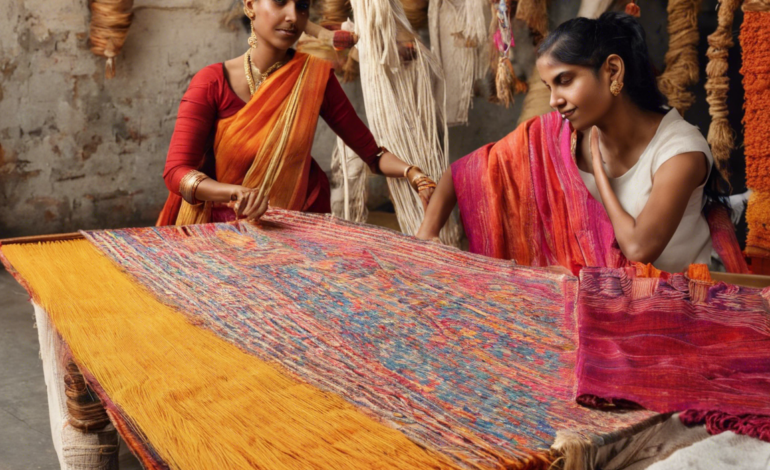
Discovering Tradition: National Handloom Day 2023
Introduction
National Handloom Day is an occasion celebrated in India on August 7th each year to recognize the importance of the handloom industry in the country. This day commemorates the Swadeshi Movement which was launched in 1905 in Calcutta Town Hall to promote the use of locally made products and to eliminate the use of British goods. Over the years, the handloom industry in India has played a significant role in the country’s cultural heritage, economy, and social fabric.
Historical Significance of Handlooms in India
India has a rich tradition of handloom weaving that dates back thousands of years. The art of weaving has been passed down through generations, with each region of the country having its unique weaving techniques, designs, and motifs. Handloom textiles have been an integral part of Indian culture, with references found in ancient texts and scriptures. The handloom industry has not only provided employment to millions of weavers but has also been a custodian of traditional knowledge and skills.
Revival of Handloom Industry
In recent years, there has been a renewed interest in handloom textiles, both in India and across the globe. The shift towards sustainable and eco-friendly fashion has brought handloom fabrics into the limelight. Designers, fashion houses, and consumers are now appreciating the craftsmanship and uniqueness of handloom products. Government initiatives such as the National Handloom Development Program have been instrumental in reviving and promoting the handloom industry in the country.
Challenges Faced by the Handloom Industry
Despite its cultural importance and economic potential, the handloom industry faces several challenges. Competition from power looms and synthetic fabrics, lack of marketing and infrastructure support, low wages for weavers, and changing consumer preferences pose significant hurdles for the handloom sector. Additionally, the COVID-19 pandemic has further exacerbated the situation, leading to a decline in demand and income for weavers.
The Role of National Handloom Day
National Handloom Day serves as a platform to raise awareness about the handloom industry, promote handloom products, and honor the weavers and artisans who keep this traditional craft alive. It provides an opportunity to showcase the beauty and diversity of handloom textiles, celebrate the craftsmanship of weavers, and highlight the need to support this sector. Through exhibitions, workshops, fashion shows, and social media campaigns, National Handloom Day aims to promote handmade textiles and encourage sustainable fashion choices.
Popular Handloom Techniques in India
India boasts a wide variety of handloom textiles, each distinguished by its weaving technique, motifs, and fabric. Some of the popular handloom traditions in India include:
1. Kanjivaram Silk: Known for its rich colors, intricate zari work, and durability, Kanjivaram silk sarees from Tamil Nadu are highly prized for traditional weddings and special occasions.
2. Banarasi Silk: Originating from Varanasi in Uttar Pradesh, Banarasi silk sarees are famous for their opulent designs, gold and silver brocade work, and fine silk fabric.
3. Chanderi Weaves: Hailing from Madhya Pradesh, Chanderi sarees are characterized by their sheer texture, light weight, and traditional motifs like coins, flowers, and peacocks.
4. Pochampally Ikat: This unique tie-and-dye technique from Telangana creates geometric patterns and designs on sarees and fabrics, resulting in a stunning visual appeal.
5. Jamdani Weaving: A traditional weaving technique from West Bengal and Bangladesh, Jamdani involves weaving intricate patterns in cotton or silk fabric, often with floral or geometric motifs.
Supporting the Handloom Industry
As consumers, there are several ways in which we can support the handloom industry and contribute to the livelihood of weavers:
1. Buy Handloom Products: Opt for handloom sarees, fabrics, and garments to support the livelihood of weavers and artisans.
2. Spread Awareness: Educate others about the significance of handloom textiles, the skill of weavers, and the need to preserve this traditional craft.
3. Choose Ethical Fashion: Make conscious choices by selecting sustainable, eco-friendly handloom products over mass-produced, synthetic textiles.
4. Attend Handloom Events: Visit handloom exhibitions, fairs, and workshops to appreciate the beauty of handloom textiles and interact with weavers.
Frequently Asked Questions (FAQs)
1. What is the significance of National Handloom Day?
National Handloom Day celebrates the handloom industry’s cultural heritage, promotes handloom products, and honors the skills of weavers and artisans in India.
2. How can I differentiate between handloom and power loom fabrics?
Handloom fabrics are hand-woven on traditional looms, often with slight irregularities, while power loom fabrics are machine-made with perfect precision and uniformity.
3. Are handloom products more expensive than mass-produced textiles?
Handloom products are typically priced higher due to the craftsmanship involved, the use of natural fibers, and the support provided to weavers for their skills.
4. Can handloom weaving be a sustainable source of livelihood for weavers?
With the right support, market access, and fair wages, handloom weaving has the potential to provide sustainable livelihoods to weavers and their families.
5. How can I contribute to the promotion of handloom textiles in India?
You can support the handloom industry by purchasing handloom products, spreading awareness, choosing ethical fashion, and attending handloom events to appreciate the craft.
6. Are handloom textiles only limited to traditional sarees and fabrics?
Handloom textiles extend beyond sarees and fabrics to include stoles, dupattas, home furnishings, and even contemporary western wear, showcasing the versatility of handloom products.
7. What role do government initiatives play in supporting the handloom industry?
Government schemes and programs such as the National Handloom Development Program provide financial assistance, training, infrastructure support, and marketing platforms for weavers and handloom clusters.
8. How have modern design trends influenced traditional handloom weaving in India?
Modern design trends have led to a fusion of traditional handloom techniques with contemporary styles, creating a new market for handloom products among younger consumers and global audiences.
9. What are some of the challenges faced by weavers in the handloom industry today?
Weavers in the handloom industry face challenges such as competition from power looms, lack of market access, low wages, and the impact of global trends on traditional designs and motifs.
10. How can the younger generation contribute to preserving India’s handloom heritage?
The younger generation can support the handloom industry by appreciating and buying handloom products, learning traditional weaving techniques, promoting sustainable fashion choices, and advocating for the welfare of weavers.
In conclusion, National Handloom Day serves as a reminder of India’s rich handloom heritage, the skills of its weavers, and the need to preserve this traditional craft for future generations. By supporting the handloom industry, consumers can not only contribute to sustainable livelihoods and cultural preservation but also embrace a unique and timeless art form that transcends trends and fashion fads.





